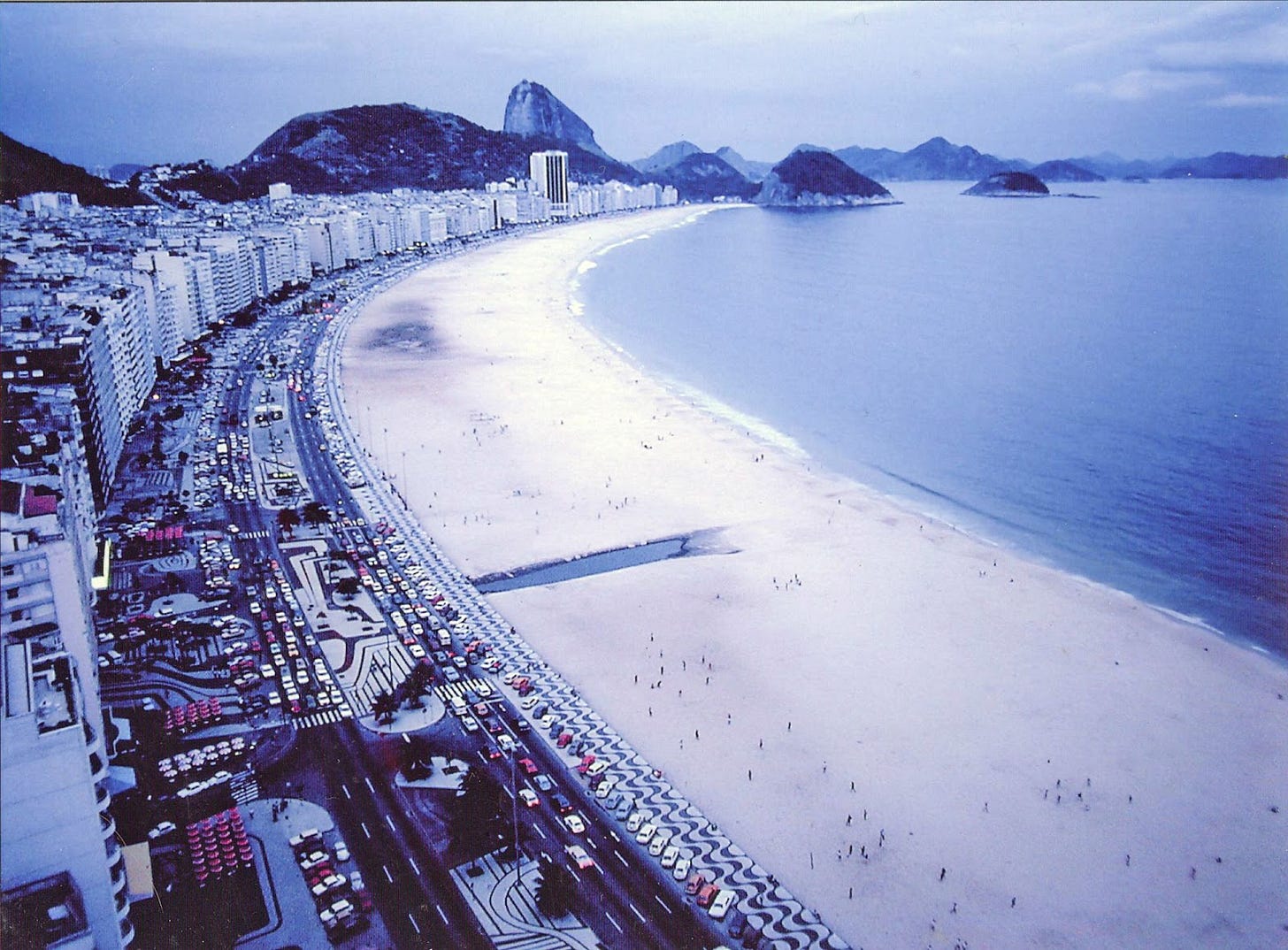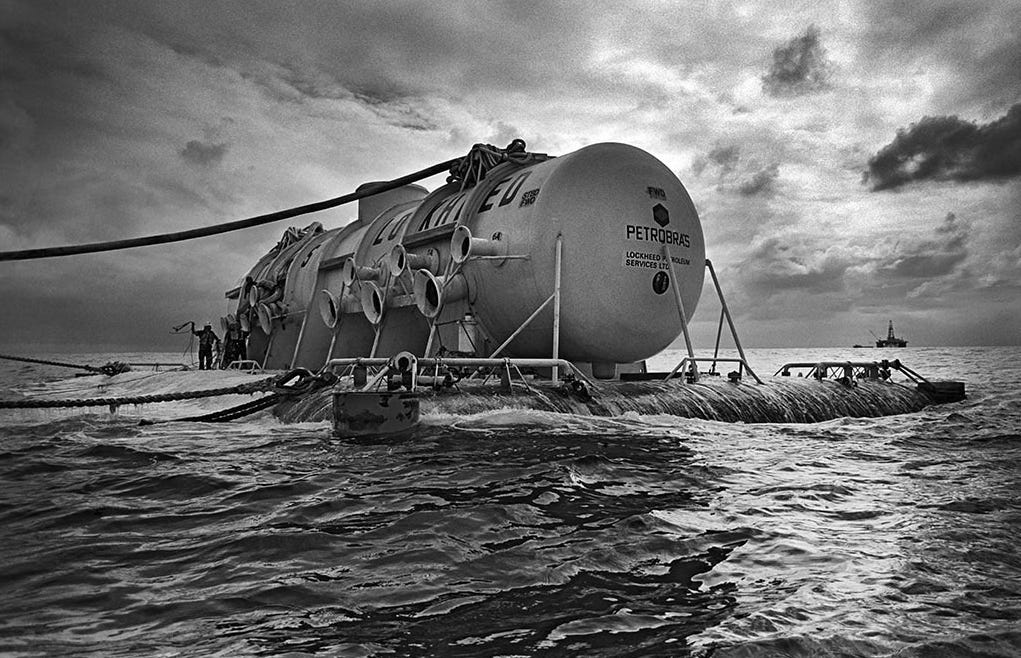Peter, how soon can you be in Rio?
A view of the South Atlantic through a porthole 200 metres below the surface provides a transcendental memory.
The urgent voice on the phone that shattered a winter Vancouver morning in 1977 was from a client. I’d recently returned from Rio de Janeiro and now they needed me back there, pronto. Things were moving fast off the coast of Brazil.
“Let me call the airlines and I’ll get back to you” is the only correct answer to that question.
That afternoon I flew Air Canada five hours non stop to New York, and that evening I boarded a flight that, after several similar recent trips, I’d begun to call “The Bone Crusher”. It was Pan American’s prestigious nonstop JFK-RIO service, flight 201.
Twelve sleepless hours aboard a 747 later, and little more than 24 hours since the phone call, I stumbled blinking into a steamy midsummer morning in Rio de Janeiro. This was my third trip on this route, so I knew what to expect. I took a cab from the airport straight to the hotel.
Located in the heart of Copacabana, the Rio Othon Palace was then the tallest structure on the beach and one of the most prestigious hotels in Rio. My room near the top floor offered unsurpassed views of the vast arc of Copacabana Beach, Sugarloaf, and on the horizon, my ultimate destination: the South Atlantic Ocean.
It was oil that brought me to Copacabana Beach. Brazil’s Garoupa oil field is located under the sea and it was the subsea collection, metering, and pumping of the oil to the surface that was my client’s business. And now it was my business, too. Lockheed Petroleum Services had hired me to film their operations for a documentary.
It was Carnival season in Rio and the neighbourhood around my hotel was immersed in the infectious rhythms and melodies of Samba. Every block, every bar had its own samba orchestra practicing, frequently right out on the street. It was the perfect soundtrack for a midwinter trip to Rio.
The rhythm of Rio was familiar now and, as I walked the mosaic-tiled Avenida Atlantica, the music and mid-summer atmosphere still stirred something in me. Even a seasoned visitor couldn't help but be moved by the stark contrast: just yesterday I'd been in Vancouver's winter grip, now here I was, strolling among the barely-clothed beach crowds of Copacabana. The mosaic-tiled boulevard, the miles-long sweep of the beach, the vendors and touts, volleyball players and Cariocas - all exactly as I'd left them weeks ago - were an intoxicating prelude to my real destination tomorrow, far offshore in the South Atlantic.
From Santos Dumont Airport, the spectacular geography of downtown Rio and its mountainous surroundings fell away beneath our tiny Cessna and an hour later, I found myself at a dirt airstrip near Campos dos Goytacazes - a stark shift from JFK's bustle two days earlier. The arrival of my next ride shattered the rural quiet: as a massive Sikorsky Sea King, the same helicopter model used for Apollo splashdown recoveries, arrived to take me to the oilfields. Thirty minutes’ flight over endless blue ocean brought us to a cluster of a dozen oil rigs. Brazil’s ocean treasure was locked beneath the ocean and the infrastructure required to recover it is impressive.
The next step on the path to my ultimate destination, one at least as exciting as a helicopter ride, would introduce me to an entirely new form of transportation.
Early the next morning, I was ready for the penultimate stage of my complex journey. The oil rig towered nearly a hundred feet above the ocean, but my immediate destination was a large service vessel, the “Superpesa”, a heavy lift barge anchored a few kilometers distant. The question was “How do I get there?” and if by boat, “How do I get down to the ocean?” The answer was a circus act compared to the relatively sedate journey I’d made so far.
On the deck of the oil rig lay a metal ring about two meters in diameter connected to a huge crane. Suspended inside the ring was a rope mesh and I was told to load my equipment onto the mesh circle and then to stand at the center of the ring. With no safety straps attached to either me or my expensive camera gear, and holding tightly onto one of the lift cables, I stood alone inside the ring, awaiting my fate.
With no drama and little warning, the crane operator lifted me and my equipment smoothly up and away from the drilling rig, out over the ocean and then down onto the deck of a small service boat far below. The skillfully-executed, yet for me daring operation was all over in a minute or so. After three days on the move, it was nearly time to stop travelling and start shooting.
My previous trips to Rio and the Garoupa oil fields were more or less a rehearsal for what was about to happen. Various technical problems had delayed the proceedings and I’d returned home in the interim. But now things were on track for the main event: the sinking. That’s why I’d received the urgent phone call.
Another boat-to-boat transfer took me aboard Superpesa, a floating industrial platform, bristling with cranes and oilfield equipment. A command center housed banks of monitors tracking operations above and below the waves. This would be both my filming base and the launch point for the last stage of my epic journey.
The oilfield’s wellheads were dispersed over a few square miles of ocean and were all connected to a central point by pipelines running across the bottom. At this central node there was to be a bus-sized chamber called a “manifold center”. The pipelines all connected to this chamber, inside which the oil was metered and pressure-regulated and then pumped to the surface where a tanker loaded the crude for delivery to the refineries ashore. The manifold center was central to the entire oil producing operation and after years of planning and construction it was now time to install it.
Designed and manufactured in Vancouver and towed halfway around the world, the manifold center was ready for its final destination. The precise placement of this multimillion dollar device onto the ocean floor some 200 meters deep was the main event I’d travelled so far to film.
The manifold center, mounted on its flotation tank, lay alongside Superpesa like a massive submarine. Workers swarmed around it, connecting control lines and checking valves. At the command to flood the tanks, the structure began its carefully controlled descent, still tethered to the barge. On the monitors in Superpesa’s control room, underwater robot cameras would track its hour-long journey to the sandy bottom.
Once the manifold center disappeared beneath the waves, the TV monitors provided the only visuals as the installation progressed. Fortunately for me and Lockheed’s film, the cameras on the submersibles provided excellent imagery and as the huge device settled onto the ocean floor, my footage of a half dozen engineers clustered expectantly around the screens told the story well.
One of the main selling points of Lockheed’s system was the fact that technicians servicing the equipment within the manifold center were able to do so in what the engineers termed a “shirt sleeve” environment. The inside of the manifold center was accessible to ordinary people and no diving gear or subsea experience was necessary.
That meant that I could go there, too.
Early the next morning, I descended to the manifold center in a diving bell - a cramped chamber about the size of a compact car. Surrounded by pipes, valves, and instruments, three of us squeezed into a space designed for two.
A single porthole about a foot in diameter halfway up the wall provided the only view outside and I filmed this as we began to submerge. It was a key shot for the story as the waves of ocean water alternately concealed and revealed the safe, familiar world of blue skies and puffy clouds outside. My view of the disappearing surface through the viewfinder gave me the willies as I tried to concentrate on photography while distracted by thoughts of my immediate future.
After ten minutes of descent, we aligned with the manifold center's docking port - a delicate operation not unlike spacecraft linking in orbit. Once secured, the space between vessels was pumped dry and we clambered down through the narrow tunnel into a different world. The cramped confines of the diving bell made the manifold center's interior feel cavernous in comparison.
Inside, 200 meters down, engineering met primal ocean. The 'shirt sleeve environment' promised by Lockheed proved optimistic - a persistent chill permeated the space and I soon wished I’d worn more than a tee shirt. My movie light carved shadows through the forest of pipes and valves, and I was conscious of the world outside, where I imagined the colossal pressure of water pressed against the hull.
The workers' operations were quite noisy, but sometimes testing and communications stopped, revealing what you’d expect would be silence. But underwater, sounds are greatly amplified and during work pauses, the ocean's voice emerged.
Each connected cable and hawser translated deep-sea currents into its own tone - low groans, metallic pings, and haunting whistles that no surface dweller was meant to hear. The familiar world of Copacabana and samba music felt impossibly distant.
The technicians stopped for lunch and I had time to stop filming and explore the vast and complex interior of this engineering masterpiece. I reflected philosophically on how a movie camera had once again exposed me to a situation impossible to experience for any but a tiny privileged few. The camea had in just a few hours taken me from dancing to samba music on the streets of Rio to the inside of a submarine on the bottom of the South Atlantic.
Eventually, our work was done and we climbed back up into the diving bell for our ride home. There were no windows in the manifold center and I found myself once again captivated by the view from the porthole.
Through the porthole's perfect circle, the ocean revealed her secret palette. What I saw moved me nearly to tears - a sublime gradient of heartbreaking blue stretching from barely visible twilight above to abyssal darkness below. No carnival costume, no Rio sunset could match this simple, stunning display. Forty years later, that view remains my fondest memory of my trips to Rio: a small, round window framing nature's perfect artistry, a view seen by so few privileged human eyes, but memorably seen by mine that day on my only journey to the ocean floor.










And lighting the interior of that thing with a Colortran Sun Gun. :)
It's true, though, that porthole view was transcendental.
Wow -- great story! 600 frickin' feet down? Ay, carumba!